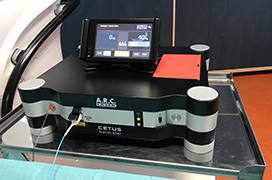Aim: To compare the safety and efficacy of a new nanolaser photofragmentation technique of cataract surgery with ultrasound phacoemulsification.
Method: A cohort of 20 patients underwent ultrasound phacoemulsification in one eye (group I) and nanosecond laser fragmentation in the other eye (group II). All cataracts were classified as stage 3 of cataract progression, i.e. nuclear opalescence (NO) was NO2-NO3 according to the used Lens Opacities Classification System III. We observed uncorrected visual acuity (UCVA expressed in decimal units) before and after surgery, as well as corneal endothelial cell density (ECD), the percentage of hexagonal cells and the pleomorphism index (PI) and corneal thickness (CT) before surgery and 7 days after surgery.
Results: In all 40 eyes the course of surgery was uncomplicated. BCVA was 0.70 ± 0.10 in group I before surgery, in group II 0.68 ± 0.10, and 7 days after surgery in group I 0.98 ± 0.05 and in group II 0.98 ± 0.04 (p-NS). Average ECD (cells/mm2) before surgery in group I was 2508 ± 205.54 bb/mm2 and in group II 2472.5 ± 287.78 bb/mm2. After surgery in group I this was 2024.92 ± 271.50 bb/mm2 and in group II 2138.50 ± 390.85 bb/mm2. The differences in the loss of endothelial cells between both groups were statistically insignificant. In a comparison of the difference of both groups upon average incidence of hexagonal cells before and after surgery, the differences were statistically insignificant, as they were upon a comparison of the differences of corneal thickness. In all the observed parameters we therefore did not record any statistically significant differences.
Conclusion: Nanolaser lens photofragmentation and ultrasound phacoemulsification can be considered of equal value from the perspective of a comparison of both methods on perioperative influence on the corneal epithelium.

